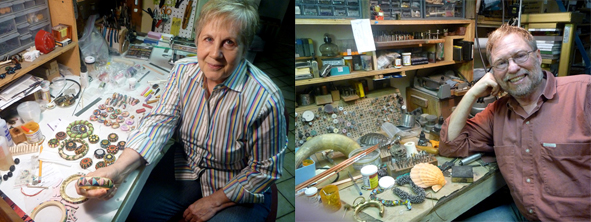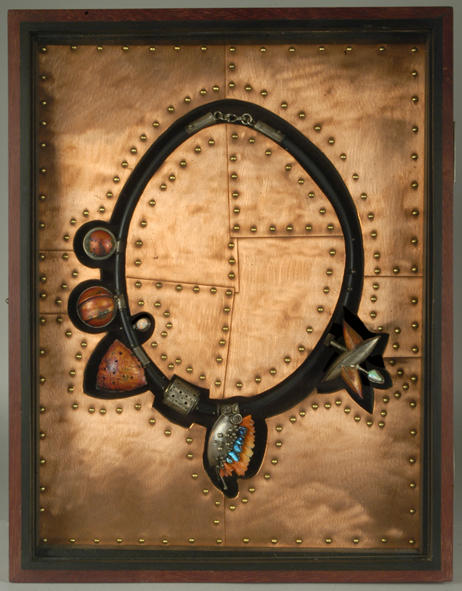Like many of my internet acquaintances, I had the privilege of finally meeting John and Corliss Rose at the 2009 SNAG Conference in Houston. They are as warm, generous and irreverent in person as I had hoped. They are also some of the hardest-working art-jewelry makers I know. Since opening their studio together in 1968, the 2Roses (as they’re known) have been fearlessly experimenting with any and every medium they can get their hands on. Along with a very busy studio practice making both limited edition work as well as one-of-a-kinds, they’ve moved into innumerable other ventures, including the recent and much needed re-launch of SNAG’s website. Their diversity and longevity outside academia initially drew my interest as I started my own studio practice in a particularly hostile economic climate after graduate school. If makers can learn to be as nimble as the 2Roses, then our field will be the better for it.


As makers, you seem to be able to wear more hats than most. You’ve maintained a vigorous exhibition record at established galleries, you’ve done the craft show circuit and you’ve cultivated a very active web presence through your Etsy site as well as Flickr and Facebook. I noticed on your site that you link to your Etsy store as a means for viewers to buy your work, but do you also have regular representation in galleries, or do you only work with them through juried and invitational exhibitions? Have you ever encountered discomfort on the part of galleries with your web presence? What are your feelings on the evolution of business ethics now that artists have an expanded audience to work with – and sell to – directly?

We have never had a channel-conflict issue with any of our galleries. This is because we see our galleries as business partners, respect the relationship and work with them for mutual benefit. This means not selling against our gallery partners, or undercutting prices. It also means respecting territory and market coverage. We had a collector contact us recently, who had seen our work in a gallery. She wanted to buy a piece from us directly. We sold her the work at the retail price and promptly sent the gallery a check for the commission. It is extremely important to us that our business partners, clients and suppliers have confidence in our integrity and ethics. Simply put, expanded access to markets has nothing to do with ethics. You either conduct your business dealings with integrity or you don’t.
At one time, gallery representation and craft shows were the entry point for most makers of art jewelry. Would you be able to go further into detail about your experiences selling in galleries, at craft shows and on Etsy and talk a little about the differences? Are there notable differences in buyers/audience?

Although jewelry is very prevalent on Etsy, there is a dearth of art jewelry. Would you encourage other makers of art jewelry to make work available on Etsy? What advice would you give them if they were to take this approach?

In a previous exchange we had about new methods of selling work you mentioned a ‘Tupperware art party.’ I think makers should be open to new methods of reaching collectors and I think it could be a great way for new converts to feel engaged in a way that galleries are sometimes unable to do. Could you speak more about the party and have you tried any other more unorthodox methods of reaching new collectors?
We are strong proponents of guerilla sales tactics and street theatrics. We take great care to cover all the traditional bases too, but we are not afraid to step outside the box and take calculated risks. Like having a Tupperware art party. These are carefully nurtured and promoted events that put a new spin on an old model attracting a different generation and segment of the collector market. Part of the point of all this is to stand out from the crowd. So many artists are trying to draw attention to how unique they are by doing the same thing that the vast majority of other artists (and galleries) are doing. Traditional promotion and sales methods are fine, but only deliver a portion of the market. There is so much more untapped opportunity out there. To grasp it you have to stretch.

Live within your means. Invest in yourself and your career. Pay careful attention to what, why, how and who buys art . . . particularly your art. Don’t wait for circumstances to change to follow your dream. Following your dream will change your circumstances.
The divide between ‘fine art’ and ‘craft’ is a favorite bête noir in the field. For beginning makers it can add another layer of identity to try and navigate through as the economy throws up more hurdles. How do you feel about the synchronicity of the slow economy with the general malaise that some feel was already pervading our field?
We feel that the ‘craft’ versus ‘fine art’ discussion is irrelevant to what we do. We don’t waste our time or energy with it. Nor do we feel that there is a general malaise hanging over the field. We are in a time of transition, evolution and revolution. Those who embrace change will reap the rewards.




